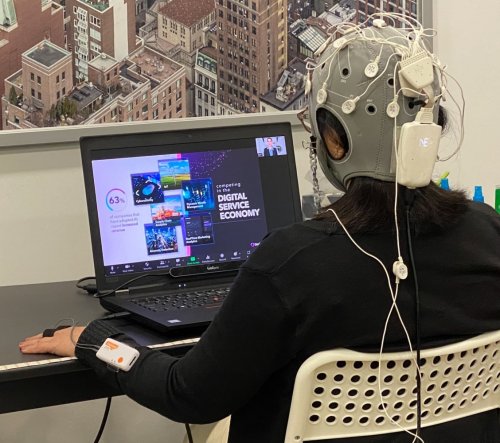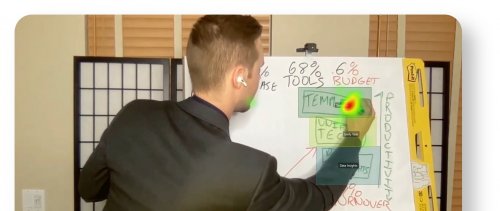Overview
What is a common belief most salespeople have about selling virtually that you can debunk with neuroscience?
This question got my attention when I saw it on a list of questions I need to answer in preparation for an upcoming webinar. In the past three years, I have completed several empirical research projects on how buyers' brains act on Zoom or while viewing digital assets. Empirical research, unlike other research, implies that we create treatment and control groups, assign participants randomly to those groups, and tweak only one element across conditions so we can establish causation.
|
We can debunk several things with neuroscience regarding remote selling in particular. For example, in one neuroscience study I conducted, I noted that it is possible to instill equality in multiple selling modalities, such as virtual, face-to-face, hybrid, and over-the-phone. We can now debunk the myth that some modalities are "better" than others. First, one would have to define "better." |
Empirical research, studying the buyer's brain and body during a virtual sales meeting |
In this study, the four modalities equally and positively impacted cognitive variables such as buyers' attention, cognitive workload, fatigue, motivation, and long-term recall of essential messages.
To reach modality equality, ask these questions when you reflect on your own content:
- Do I have a clear message I want people to remember, and do I repeat it multiple times? In this study, the main message was repeated 3 times verbally and 7 times visually during a 7-minute presentation.
- Am I sharing slides that follow universal design rules? In this study, the deck included clear information hierarchy (which messages were subsets of other messages), proximity (grouping related ideas), and contrast, created perceptually by opposing shapes and colors and conceptually by opposing ideas, such as old way vs. new way.
- Am I combining analytical and emotional language? In the sales presentation we studied, which promoted the Xactly platform for incentivizing sellers, the language switched from statements such as "45% of compensation plans lead to the wrong employee behavior" or "88% of spreadsheets used for monitoring compensation have errors"...to "compensation technology is outdated." Even though big data is a trend in compensation, the seller said, you have to deal with "big data, small insights." This balance of the emotional and logical ignited reactions and sustained attention.
- Do you deliver messages at a brisk pace? In this presentation, we sustained a brisk pace with 33 animations per slide, and there was a slide change approximately every 30 seconds. This pace made it difficult for the brain to predict what was happening next and to look elsewhere.
- Is the presenter exhibiting impeccable delivery skills? You can monitor this by gauging the effectiveness of hand gestures, vocal variety, and eye contact.
Combining these techniques impacts cognition equally across modalities and helps you transcend the illusion that face-to-face is better than virtual or that hybrid is doomed. However, this brings us to the next question on the list.
Are virtual sales presentations challenging, even for an experienced seller?
Expert sellers face challenges, but those can happen regardless of modality. Thinking of virtual meetings in particular... it's easy to revere them for flexibility in scheduling, time and financial savings, larger group attendance, health safety, lower carbon footprint, and recording capabilities for those who cannot attend. However, there are still challenges around large time zone differences, lack of complete immersion, and even lack of serendipity, which you might have in face-to-face settings.
But...
Face-to-face meetings can be just as challenging as virtual ones.
The buyer's brain knows how to fake interest by smiling, nodding, and making eye contact while focusing attention internally. The brain goes in and out of a conversation, which can happen when the buyer sits right under your nose. Sellers may relate to this experience of a disconnected connection: while they are in the same room, members of the buying group do not relate to each other much; each is using their phone to maintain connections with a world beyond that room - a world they might control and change more easily.
Some constantly hug their phones because they are prone to boredom, loneliness or have no one to relate to. Some have a constant desire to sustain a heightened sense of status and self-esteem. How do you tackle this state of connected disconnectedness in both face-to-face and virtual settings?
Give them an alternative in the present. One way to make the present moment attention-worthy is to offer value so your audience cannot be tempted to go elsewhere, even in their own mind. In business content, I often notice that people try to impress with facts, not value. Your buyers could know all the facts but not know what's important.
Clarify value, not just facts.
|
Balance your presentation with value and facts |
I like this example because it reminds us of the product's value in addition to facts. When value is clear, you can ensure that buyers' attention is not divided into small slices. And this is how you influence decisions too, regardless of the delivery medium, because decisions depend on value. |
What’s the most underutilized virtual selling technique in your way of looking at things?
In two neuroscience projects I've completed lately, we've demonstrated the merits of using whiteboards in virtual environments. Both studies showed that the whiteboard approach has several advantages compared to other media, such as animated drawings and PowerPoint slides.
|
Heat map of a drawing on a whiteboard during a virtual session, showing visual attention to important elements |
When you use a whiteboard, you can attract attention to specific elements at a certain location. However, seeing the seller move and observing action evokes the same visual stimuli, motor movement, and tactile sensations for the viewer. The mirror neuron system contains neurons that fire when we undertake an action or observe others undertaking the same action. fMRI studies also show that motor portions of the brain recreate physical experiences when we read, see, or hear them.
So, one of the main advantages of the whiteboard is that it helps us see the information through movement, through our bodies, leading to better attention (and sustained attention), Eureka effects, and better content recall.
Tell us about the last riveting virtual sales presentation you sat through. What made it good/interesting?
I attended a few virtual sessions with a customer success manager who works for a software platform I often use for my research. The sessions were intended as teaching sessions, but when she showed me a few features, she also alluded to aspects of the platform I might want in the future. The ratio felt just right: two parts teaching, one part persuasion. Even in the whiteboard example above, the seller was mainly educating the customer regarding marketing trends, and only a small portion at the end was explicitly spent on promoting a software platform.
When you reflect on your persuasion style, do you have the proper proportion of sales to service? With the right ratio, you can make an impact regardless if you're presenting from an off-site living room or an on-site conference room.
Carmen Simon, Ph.D., is the Chief Science Officer at Corporate Visions. She uses neuroscience tools to research how the brain processes business messages, remembers them, and decides to act (or not). The research is translated into practical guidelines, which sellers and marketers use to interact with B2B customers, available in the CVI advisory platform.
Categories





